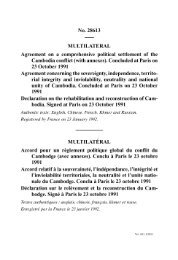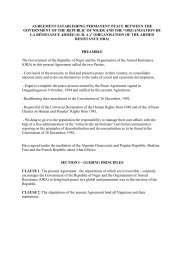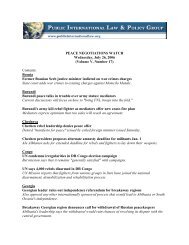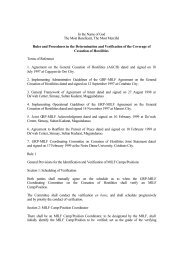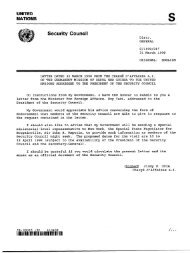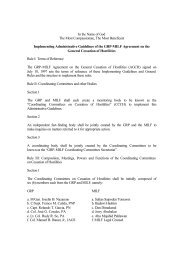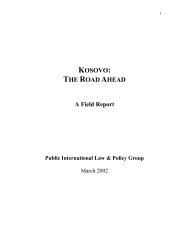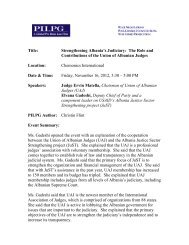The United States, China, and Taiwan - Public International Law ...
The United States, China, and Taiwan - Public International Law ...
The United States, China, and Taiwan - Public International Law ...
Create successful ePaper yourself
Turn your PDF publications into a flip-book with our unique Google optimized e-Paper software.
<strong>China</strong>'s dominant military concept now is to be prepared to fight high--tech limited wars on itsperiphery against weaker opponents. To accomplish this, <strong>China</strong> conveys the perception to theoutside world that it is backward ---- as Sunzi said: "When capable, feign incapacity" ---- but atthe same time stakes out its territorial claims in domestic National Peoples' Congress (NPC)legislation. <strong>The</strong> NPC law of 1992, claiming the Spratly, Diao Yu Dao Isl<strong>and</strong>s, <strong>and</strong> <strong>Taiwan</strong> <strong>and</strong>reserving the right to use force, backs up these claims. Is this contrast between modernizing[*746] its military, insisting it is obsolete, <strong>and</strong> then claiming the seas around <strong>China</strong> a seemingcontradiction? Yes, it is, but if you are not prepared to deal with contradictions, then you do notbelong in the <strong>China</strong> business.<strong>China</strong> has a track record of frequently using violence to sort out sovereignty issues on itsperiphery, so the isl<strong>and</strong> chain concept is not entirely new. As Jonathan Wilkenfeld, head of theUniversity of Maryl<strong>and</strong>'s ICONS project has pointed out, <strong>China</strong> has used force more frequentlythan any other nation since 1949, citing Vietnam, Burma, India, Soviet Union, Korea, <strong>and</strong><strong>Taiwan</strong> Strait ---- all instances where force was used. Justifications for the use of force can bedebated; the fact that force was used cannot be.Historically, <strong>and</strong> history certainly counts in current Chinese calculations (certainly more thanwith the U.S.), John K. Fairbank, who paid a lot of attention to the trends of dynastic history,carefully <strong>and</strong> wisely came up with three Chinese principles governing its strategy:(1) stop the primary threat from the l<strong>and</strong> ---- the Great Wall was built at enormous cost to stopthe northern barbarians. It was not always successful, given the Mongol <strong>and</strong> Manchu victories;(2) downgrade sea power ---- with some notably brief exceptions in the southern Song <strong>and</strong> earlyMing dynasties;(3) establish moral superiority ---- ultimately it is not force of arms but the superiority of yourcivilization which exp<strong>and</strong>s your influence <strong>and</strong> protects the motherl<strong>and</strong>.As with all principles, at times they were followed, <strong>and</strong> at times they did not work. Certainly, theeunuch Admiral Zheng He's seven maritime expeditions in the early Ming dynasty, when <strong>China</strong>ruled the waves, was abruptly stopped to turn inward <strong>and</strong> to build <strong>China</strong>'s strength <strong>and</strong> protect itagainst any resurgent Mongols in the north. In the Qing dynasty, a major miscalculation wasmade when Li Hong--zhang, who wanted to build up <strong>China</strong>'s sea power after the disastrousOpium War, was overruled by the emperor in favor of Zuo Zong--tang, who wanted toemphasize l<strong>and</strong> forces against the Russians <strong>and</strong> Mongols in the north. <strong>The</strong> result was a disasterfor <strong>China</strong> as the major threat continued to come from the sea ---- Japan in 1895 <strong>and</strong> 1931. <strong>China</strong>also experienced humiliation at the h<strong>and</strong>s of eight foreign powers during the Boxer Rebellion in1900, <strong>and</strong> these forces came from the sea as well.Recently, <strong>China</strong> has been torn. Certainly in the 1950s, during the heyday of Sino--Sovietcooperation, <strong>China</strong>'s military industrial strength moved inl<strong>and</strong>, led by Chinese revolutionariesfrom inl<strong>and</strong> provinces such as Hunan, Sichuan, <strong>and</strong> Shanxi. <strong>The</strong> coastal areas dominated by[*747] foreign colonialists were decimated ---- Shanghai was a main target.



